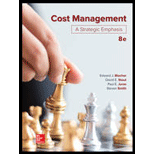
1.
Calculate the costs per equivalent unit for both the weighted-average method and FIFO method.
1.
Explanation of Solution
Equivalent units: Equivalent units are the number of units that could have been performed given the amount of work actually performed, and for both partially complete units and complete units, the quantity of other production inputs used.
Calculate the costs per equivalent unit for direct materials using weighted-average method:
Hence, the costs per equivalent unit for direct materials using weighted-average method is $1.8250.
Calculate the costs per equivalent unit for conversion using weighted-average method:
Hence, the costs per equivalent unit for conversion using weighted-average method is $3.4500.
Calculate the costs per equivalent unit for direct materials using FIFO method:
Hence, the costs per equivalent unit for direct materials using FIFO method is $1.7500.
Calculate the costs per equivalent unit for conversion using FIFO method:
Hence, the costs per equivalent unit for conversion using FIFO method is $3.6500.
2.
Explain the difference between the equivalent unit costs of FIFO method and weighted-average method.
2.
Explanation of Solution
Due to the per unit amount differences in current costs and beginning work-in-process, there are differences between the equivalent unit costs of FIFO method and weighted-average method. The cost per equivalent unit is based on current costs only, under the FIFO method, while in the weighted-average method, these differences are averaged together.
Want to see more full solutions like this?
Chapter 6 Solutions
Cost Management
- What is the annual depreciation expense ?arrow_forwardOn April 1, Usain Enterprises purchased machinery at a cost of $150,000, with a depreciable cost of $120,000 and an estimated useful life of 4 years. Using the straight-line depreciation method, calculate depreciation expense for the first year, which ends on December 31.arrow_forwardStep by step solution for general accountingarrow_forward
- Please explain the solution to this general accounting problem with accurate principles.arrow_forwardCorona Distributors has received an invoice totaling $80,000 with payment terms of 2/15, net 60. This means the buyer can avail a 2% discount if the invoice is paid within 15 days; otherwise, the full amount is due in 60 days. How much does the buyer save if the bill is paid within the discount period a. $800 b. $1,600 c. $2,400 d. $3,200arrow_forwardI need the correct answer to this financial accounting problem using the standard accounting approach.arrow_forward
- Can you solve this financial accounting question with the appropriate financial analysis techniques?arrow_forwardI am searching for the correct answer to this general accounting problem with proper accounting rules.arrow_forwardCan you solve this general accounting problem with appropriate steps and explanations?arrow_forward

 AccountingAccountingISBN:9781337272094Author:WARREN, Carl S., Reeve, James M., Duchac, Jonathan E.Publisher:Cengage Learning,
AccountingAccountingISBN:9781337272094Author:WARREN, Carl S., Reeve, James M., Duchac, Jonathan E.Publisher:Cengage Learning, Accounting Information SystemsAccountingISBN:9781337619202Author:Hall, James A.Publisher:Cengage Learning,
Accounting Information SystemsAccountingISBN:9781337619202Author:Hall, James A.Publisher:Cengage Learning, Horngren's Cost Accounting: A Managerial Emphasis...AccountingISBN:9780134475585Author:Srikant M. Datar, Madhav V. RajanPublisher:PEARSON
Horngren's Cost Accounting: A Managerial Emphasis...AccountingISBN:9780134475585Author:Srikant M. Datar, Madhav V. RajanPublisher:PEARSON Intermediate AccountingAccountingISBN:9781259722660Author:J. David Spiceland, Mark W. Nelson, Wayne M ThomasPublisher:McGraw-Hill Education
Intermediate AccountingAccountingISBN:9781259722660Author:J. David Spiceland, Mark W. Nelson, Wayne M ThomasPublisher:McGraw-Hill Education Financial and Managerial AccountingAccountingISBN:9781259726705Author:John J Wild, Ken W. Shaw, Barbara Chiappetta Fundamental Accounting PrinciplesPublisher:McGraw-Hill Education
Financial and Managerial AccountingAccountingISBN:9781259726705Author:John J Wild, Ken W. Shaw, Barbara Chiappetta Fundamental Accounting PrinciplesPublisher:McGraw-Hill Education





